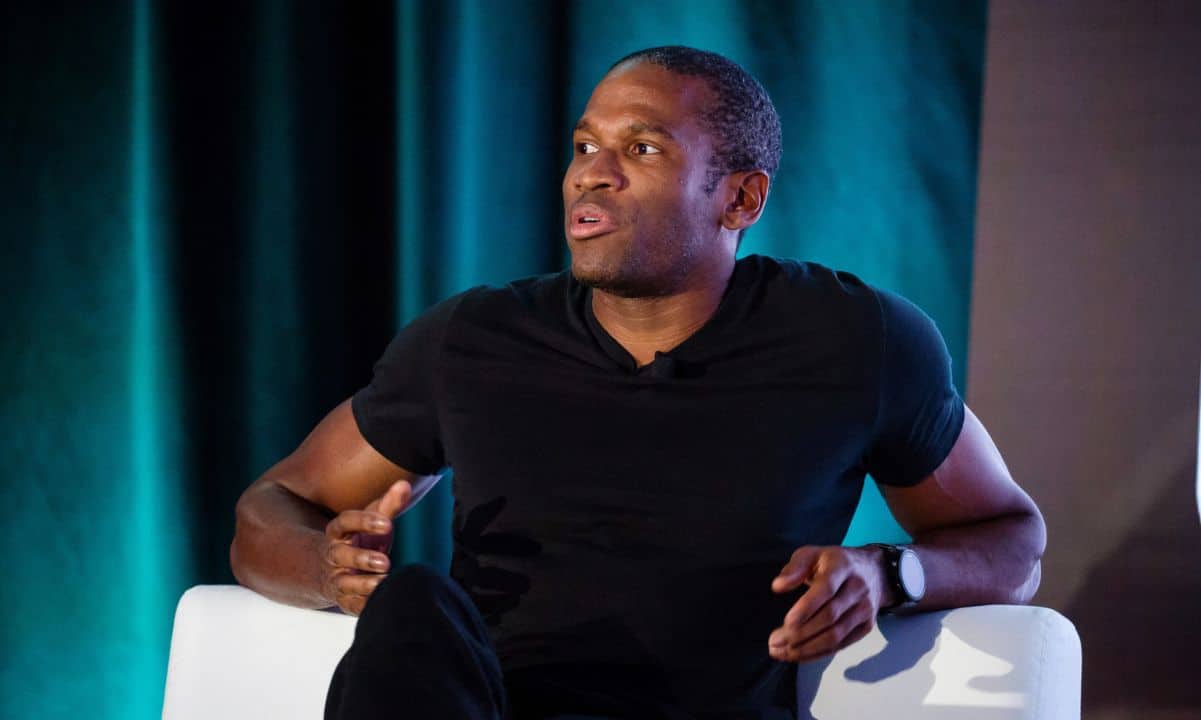Author: The Rollup
source:The Rollup X Account
Compiled by: Azuma,
Editor's note: The Rollup, a well-known cryptocurrency-themed interview channel, updated the latest issue of the conversation today. The guests of this issue are Arthur Hayes, co-founder of BitMEX, who has a good record in market forecasts in recent times, and Mike Silagadze, CEO of ether.fi, who has just launched a $40 million fund.The interview content involves multi-layer content such as market forecasting, ETH/BTC price performance, BTC and gold, and fundamental analysis.
The following is a selection of some of the contents of this interview (focusing on Arthur Hayes' speech), compiled by.

Q1: Has the callback ended?
Arthur Hayes:I think the market has definitely bottomed out around $74,500.At that time, the Trump team took an extreme stance on tariff issues, but under the pressure of a plunge in the financial market, they had to choose to compromise - after all, the Trump team was still under pressure from the 2026 midterm elections.
So the market has bottomed out, the funds have returned, and Bitcoin has rebounded by about 25%. Remember the market lows after the FTX crash in 2022? At that time, Yellen chose to reduce the reverse repurchase from $250 million to 0, and then Bitcoin rose nearly 6 times, and I think we will see a similar upward pattern, which is the beginning of Bitcoin’s move towards $1 million.
Q2: How long can the liquidity and positive sentiment in the market last? Is the rise still related to Trump-driven rate cut expectations?
Arthur Hayes:Excessive focus on interest rate cuts is a bit inverted to the cart.People always want to apply the experience from 2008 to 2019 - As soon as the quantitative easing policy was released, the Federal Reserve printed money every week, and we could make steady profits when we bought assets, which has become a conditional reflection of the financial market.But now the rules of the game have changed. When ordinary people realize that quantitative easing means inflation, and inflation affects the election situation of the ruling party, the policy toolbox must be updated. 2022 年底耶伦的操作就是典型案例 —— 虽非名义上的 QE,却通过某种形式创造流动性,推动股市、加密货币和黄金在随后 18-24 个月暴涨,直到特朗普就职。
Now people are still waiting for Powell to cut interest rates or restart QE, which is completely a carving boat to seek a sword.
The US Treasury Department is currently implementing a bond repurchase program. Although it is not as straightforward as QE, it is essentially providing leverage for Treasury buyers.As the government deficit expands, trillions of dollars of new debt will pour into the market, which means liquidity is still injecting, just changing the vest. If you have to wait until the traditional QE signal is in, you may still be waiting and watching when Bitcoin rises to $500,000.
The data that really needs to be paid attention to is volatility, especially the Bond Market Volatility Index (MOVE).When the index breaks through 140, policy makers will definitely intervene: for example, after reaching 172 during the trading session on April 8, JPMorgan Chase CEO Dimon immediately criticized Trump's tariff policy on TV, and Trump immediately changed his course; after MOVE breaks through 140 in September 2022, Yellen quickly adjusted the bond issuance structure, and the market rebounded. History has repeatedly proved that as the financial system leverage ratio rises, policy makers’ intervention thresholds are lowering.
Trump's "volatility manufacturing machine" is precisely the favorable thing for Bitcoin. He is accustomed to the strategy of "extreme pressure-test reaction-fast turn", and this unpredictability is exactly the favorite nutrient in the crypto market.We don’t need to predict the direction of the policy, we can make money as long as the volatility increases——Because the highly leveraged financial system cannot withstand violent fluctuations at all.
Q3: The rise of gold is equally fierce. Do you want the rise logic of Bitcoin and gold to be the same?
Arthur Hayes:I think gold and Bitcoin are different expressions of the same phenomenon, just that the groups that buy them are different.
Ultimately, I think you hold gold because the central bank will buy gold, and you hold Bitcoin because the global retail people will buy Bitcoin. What they want to escape is the same thing—excessive inflation, and the possible collapse of the post-war statutory financial system.
Q4: Why does debt refinancing inject liquidity into the system?
Arthur Hayes: The key is to understand the operation of "basis trading". Hedge funds use the price difference between spot bonds and futures contracts, and are combined with high leverage arbitrage. As the Ministry of Finance relaxes bank capital requirements, these funds can participate in Treasury bond auctions with higher leverage.Although the Ministry of Finance’s repurchase plan itself does not create liquidity, by maintaining the operation of the treasury bond market, the Ministry of Finance can continue to issue additional bonds—— Against the backdrop of a 22% surge in deficit ratio (the first six months of fiscal year 2024 compared with the same period last year), this mechanism is essentially maintaining liquidity supply through financial engineering.
Q 5: Which tokens can outperform Bitcoin? Will it be those tokens that have real gold flow?
Arthur Hayes:This reminds me of Buffett's famous saying: "Price is what you pay, value is what you get."
The key to this problem depends on the entry price - if you buy ether.fi for $0.55 (Note: Another guest in the interview is Mike Silagadze, CEO of ether.fi), assuming that Mike described the vision may indeed outperform Bitcoin, but if you take over at an inflated price, even if the project generates another $1 billion in revenue, the percentage gain from that basis point will be hard to beat Bitcoin.
Any asset may surpass Bitcoin, but depends on two variables: the buy price range, and the income growth curve during the holding period. There are many cash flow tokens that are underpriced, and when the "copy season" or "fundamental season" comes (i.e., the peak phase of Bitcoin dominance).
Q 6: Has Bitcoin’s market share peaked?
Arthur Hayes: I don't think so.
Institutional investors and family offices are now experiencing cognitive awakening - Trump has broken the illusion of "American exceptionalism" and exposed the essence of this empire's priority in taking care of basic voters over capital security.
This batch of funds will begin to understand the significance of Bitcoin. They will increase their holdings of gold, reduce their holdings of Nasdaq and U.S. bonds, and instead allocate assets that are decoupled from the current system.This migration will first focus on Bitcoin rather than other tokens - the rich will not buy altcoins as soon as they come up.
Q 7: I heardMaelstrom (Arthur Hayes’ fund) is doing some mergers and acquisitions to integrate new crypto businesses?
Arthur Hayes:We are operating a small M&A fund.There are some crypto businesses with good cash flow that are misunderstood by traditional investors for some reason.
We have a lot of flexibility in capital deployment because it is all my own money and there are no investment memorandum (PPM) restrictions.We are looking at several companies that may make leveraged acquisitions of one of them to improve their business as a sponsor.There are many segmented high-cash flow businesses in the crypto space, which may not be entirely blockchain businesses, but service providers. Traditional private equity investors don’t like them because they are not companies like Coinbase with high growth potential. But if this field is assumed to grow, we need some services that can only be provided by crypto-native institutions.
Q 8: At this stage, what are your criteria for screening assets?
Arthur Hayes:First of all, what I am looking for is an agreement or business for those users to pay for real money.——It is not based on token incentives, but users pay their own stablecoins or other cryptocurrencies to purchase services. The most typical example is exchanges. For example, Hyperliquid is a model, which accounts for 10-20% of the perpetual contract market from zero within 18 months. They built an extremely efficient order book system, and the handling fees paid by users are directly used for token repurchase, which makes sense only by this simple and direct business model.
The second key is how token holders benefit.Nowadays, many projects that make a lot of money (such as some top DEXs), but token holders don’t get a share. Take Uniswap as an example - No matter how much you make a protocol, it is useless to hold UNI, which is why I don’t pay attention to its price at all. If the project party starts by issuing coins to raise funds, but does not allow the community to share the income after the agreement is successful, it is simply a hooligan.
My core standards for investing in tokens are very clear: first, there must be real paid users, and second, we must establish a clear profit distribution mechanism - whether through repurchase, dividends or other forms. In this way, I can calculate the expected APY, conduct a cash flow discount analysis, and determine whether the current valuation is reasonable.I have been patiently planning this type of project over the past month and a half because the irrational selling of the market has created an excellent buying point - the over-selling of "not Bitcoin" just because it is "not Bitcoin", has caused the agreements with strong cash flow to have a gold pit.
















No comments yet